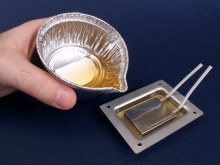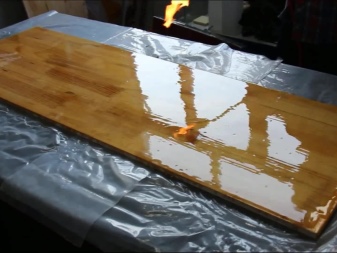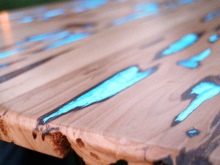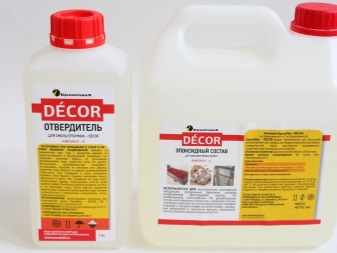Description of epoxy resin and the nuances of its choice

A durable adhesive that can glue almost everything except plexiglass, polyethylene, as well as nylon and some other non-porous substrates is epoxy resin. This substance is widely used in construction and finishing works, as well as in needlework and creativity. Its use has its own characteristics, they will be discussed in our review.


What it is?
Epoxy is an oligopolymer. It consists of a number of epoxy groups, which polymerize when reacted with a hardener. The most in demand are products obtained as a result of the synthesis of polymers based on bisphenol and phenol epichlorohydrin. ES has a liquid consistency, its specific gravity is 1.07 g / cm3. It can be transparent or colored, in most cases in stores you can find substances of white or yellowish-orange colors, they look like liquid viscous honey.
The main advantage of epoxy resin is that it is widely used as an adhesive and is topical as a laminate. Epoxy possesses exceptional properties of a thin film and is resistant to microcracks, elongates up to 5% when stretched.



The product has high moisture resistance parameters, is able to adhere to a wide variety of substrates - metal, wood or uncured laminate. The shelf life is quite long - up to 1 year.
Of the minuses, the high cost of the product and the need to observe safety precautions during work can be noted. The product requires the use of additional components - hardeners, plasticizers. In addition, skill is required to create decorative coatings.



Composition and manufacturing features
ES refers to complex compounds; it manifests its physical and technical characteristics exclusively in the form of a polymer. When reacted with hardeners, oligomers form the structure of many crosslinked polymers. Produced in accordance with GOST 10587-84. Speaking about the composition of the epoxy, it should be noted that it can be modified by physical or chemical methods.
Chemical technology involves a reaction with additional substances, as a result, the formula of the basic substance changes, the very structure of the polymer cell is transformed. For example, upon reaction with polyesters of alcohols of the glycidyl group, the elastic parameters of the hardened resin change. Together with this, its moisture resistance also changes. And by introducing organohalogen or organophosphorus compounds into the structure, it is possible to multiply the flammability of the material.


When epoxy reacts with formaldehyde resin, a one-component composition is formed, it hardens only when heated without the use of a hardener.
The physical technique involves mixing ES with individual additional substances without starting a chemical reaction. Thus, the addition of rubber increases the parameter of absorption of mechanical energy during impacts. And when mixed with titanium dioxide, the visual characteristics of the resin change - it becomes completely opaque to the rays of the UV spectrum.


Characteristics and properties
ES is characterized by resistance to halogens, as well as caustic alkalis and acids. It dissolves in acetone and some esters without forming a film. Let's dwell on the parameters of epoxy resin.
The hardened ES retains its shape and volume. This property allows the production of molds and other products. After hardening, the resin hardly shrinks, so the volume of the workpiece remains unchanged.
Most resins are resistant to abrasives and aggressive solutions. This allows you to use any detergent compositions when working with epoxy products. Even if small defects appear on the coating, with a small supply of epoxy, they can be easily and quickly eliminated.


ES is waterproof, this property plays a major role in the choice of finishing materials in rooms with high humidity. For example, kitchen countertops made of epoxy have a long period of use, while furniture modules made of fiberboard, due to frequent exposure to moisture, deteriorate very quickly.
The glossy surface of the hardened resin is UV-resistant. Throughout the entire period of use, the products do not fade and do not lose their aesthetic appearance.



Possessing increased heat resistance, the composition boils at +155 degrees, with more "hot" exposure it begins to melt. The substance belongs to the II class of danger, does not ignite even if it is brought into an open fire. These characteristics are typical for all types of ES. However, they can appear to varying degrees depending on the additives used in the preparation of the epoxy.


Harm to health
Many users are concerned about the harmfulness of epoxy-based resins. After curing, the epoxy is completely harmless to the health of children and adults. But in the factory, when a substance hardens, particles of the sol fraction often remain in the composition, in a dissolved state it is dangerous to humans. However, in production, most of the processes are automated, so the risk of harmful effects of such products on the body is minimized.


But before curing, epoxy is characterized by toxicity and can have a negative effect on human health. The safety rules establish that it is possible to work with ES only with personal protective equipment. This primarily concerns the respiratory system, since the resin releases harmful vapors before the final solidification. Work with ES should be in a ventilated room or in a room with an exhaust hood. Only a respirator can completely protect the respiratory system from inhaling their vapors. If you accidentally swallow the resin or get it in your eyes, seek immediate medical attention.

Description of species
There are several classifications of ES, most of them are rather technical in nature.


Epoxy Diane
Widely in demand in the industrial sector and in everyday life. Includes several varieties.
- ED-22 - begins to crystallize during prolonged storage. It is a versatile raw material, but it is used only in the industrial field.

- ED-20 - liquid epoxy, requires the mandatory introduction of a hardener. It is in demand due to its versatility combined with affordability.

- ED-16 - a composition of increased viscosity, has found distribution as a binder in the manufacture of fiberglass.

- ED-10 and ED-8 - dense heat-resistant epoxy, are included in the potting mixtures for radio engineering.

ED for paints and varnishes
These include.
- E-40 and E-40r - fast drying resins for paints and varnishes. They can be included in the structure of varnishes, enamels and putties.

- E-41 - this resin in its operational parameters corresponds to E-40, but can also be included in adhesive mixtures.

ES in the structure of varnishes and paints can be seen in most modern household appliances.
It is epoxy paints that are used in the manufacture of washing machines, microwave ovens, as well as dryers and similar products.
Aluminum, cast iron, lithium and cast steel work well with this material.

Epoxy modified
- KDA-2 - relevant as an electrical insulator. It is a basic binding ingredient in the production of fiberglass, can be used as a component for adhesive solutions.

- K-02T - is necessary for cementation and impregnation of various winding products.

- EZ-111 - found application in the field of filling radio components. It is the main component of transformer sealing.

- UP-563 - characterized by increased adhesion, in demand in the production of double-glazed windows. Acts as a potting compound.

- Outdoor furniture-153 - high quality sealant.

Special purpose
- EA - characterized by reduced viscosity, is irreplaceable in the production of solvents and resin-based impregnations.

- UP-610 - is characterized by increased hardness.

- EHD - a composition with the presence of chlorine, has a low flammability, atmospheric and heat resistance.

Top manufacturers
A wide range of resins of various brands is sold in Russia - Novol, Ekovanna, Yugreaktiv, Moment, as well as Epital and Leonardo.
The TOP manufacturers are included.
- EPS 2106 - a two-component epoxy for the formation of coatings on porous materials.
- "Art-Array" - a composition with a low viscosity, made on the basis of a modified epoxy and a hardener. When coating surfaces, it gives them a glossy shine.
- "Artline Crystal Epoxy" - optimal for creating jewelry and crafts.
- "Etalon Optic" - optimal for casting countertops and decorative items.
- Pebeo Crystal Resin Gedeo - a colorless epoxy for creativity, sold in small packages and has an affordable cost.
- Epoxy Max Decor - resin for repair and finishing works, usually combined with marble and granite chips.
- "Compound K-153" - are indispensable for sealing elements and assemblies exposed to high shock loads and vibration.


How to choose?
When choosing an epoxy resin, one must proceed from the peculiarities of its use. All varieties can be conditionally divided into two categories.
- Structural - used in tuning, shipbuilding, bonding and repair.
- Decorative - are relevant for the creation of jewelry, sculptures and paintings.
The former should be firm, firm and quick-hardening.
Sold in packs of 5 liters. For the latter, the requirement for transparency comes to the fore, as well as resistance to UV rays, which can cause yellowing of the composition.
Sold in low dosage.


Where is it applied?
All types of epoxy can be divided into groups according to their areas of application. So, in the construction industry, epoxy is used for marking on highways, decorating self-leveling floors. As a decorative material, it has become widespread in repair and finishing works. As a part of carbon and fiberglass, it has found application in repairing reinforced concrete structures and airports. Epoxy allows the bonding of bridge structures.
Resin is used to produce compressor blades and boat propellers. They have found application in the production of tanks and vessels. In mechanical engineering, resin can be used to correct casting defects. The density of the composition allows you to make springs, as well as springs. The polymer has found wide application in the field of aircraft construction - resin-based composite components are used to cover the wings and components of a jet engine, as well as empennage and competition of nozzles. It is from ES that fuel tanks and housings of parts in rockets are made.

Thus, in the industry, ES are most widely used in machine, aircraft, ship and rocket building.
Resins in the food industry have limited use - some compounds are used in the manufacture of cans. Due to its environmental friendliness, epoxy can be used in the household area without restrictions. It is used to create jewelry and interior decor elements. Resin is used to make small sculptures and furniture.

How to work with resin?
When working with resin, the main thing is to carefully observe the proportions, since an insufficient or, conversely, too large amount of hardener has the most negative effect on the functionality of the final composition. With an excess volume of the hardener, the composition loses its strength. In addition, excess can be released to the surface as it hardens. With a lack of hardener, some of the polymers remain unbound, such a composition becomes sticky.
Modern formulations are usually diluted in the proportion: for 1 part of the curing agent - 2 parts of the ES, the use of equal proportions is allowed. Stir the epoxy and hardener thoroughly so that the consistency is uniform. Stirring is performed slowly, if the movements are sharp, bubbles will appear.

Keep in mind - polymerization does not start immediately, first you need to wait until the composition reaches the optimal consistency and only then you can start working.
After pouring, wait until the resin hardens. In the course of polymerization, ES goes through several stages.
- Liquid state. The mixture of the main components easily drains from the stirring rod, this moment is optimal to pour the composition into the mold.
- Thick honey. In this state, the mass does not lay down in a thin, even layer, but easily fills a small volume.
- Candied honey. At this stage, it is not possible to carry out any actions with the resin, the only possibility of use is gluing surfaces.
- The transition from honey to rubber. At this point, the resin does not need to be touched, otherwise the formation of polymer chains can be disrupted.
- Rubber. The mass of the components has already entered into interaction and has ceased to stick to the palms, however, its hardness is not enough yet. In this state, the workpiece can be twisted and deformed.
- Solid. This resin does not bend, twist, or pick out.

Epoxy from different manufacturers has a different cure period, it is determined only empirically.
If desired, the epoxy can be additionally coated with a colorless varnish.
However, even without varnish, its surface looks glossy and shimmery.

Advice
In conclusion, we will give a few recommendations that will make working with epoxy more comfortable.
- Before starting work, cover the work surface with a plastic tablecloth or plastic wrap. It is not worth using paper - ES saturates it, so it will not be able to protect it from stains.
- Do not wet epoxy and hardener. Do not work with ES in rooms with high humidity, otherwise solidification will be extremely slow.
- Special toners can be used to give the epoxy a vibrant color. As a budget analogue, you can take the ink of ordinary gel pens.
- Do not work with ES in a very hot room, at temperatures above 22 degrees, the composition hardens poorly.
- If the resin has been stored for a long time in an unheated room, then flakes often appear in it. To return her decorative appearance - warm up the composition to 50-60 degrees.
- When working with wood, it is necessary to use plasticizers - they make the resin elastic and soft. Otherwise, when the humidity changes, the wooden base will begin to deform, and the adjacent ones will crack.

How to choose an epoxy resin, see below.













The comment was sent successfully.